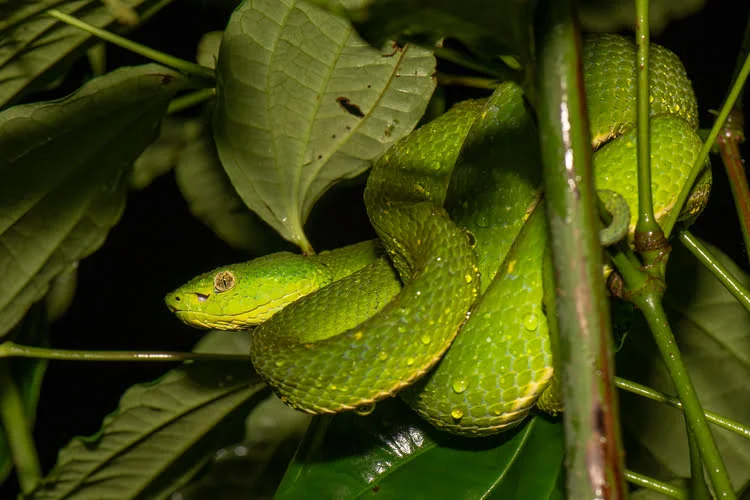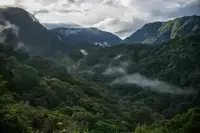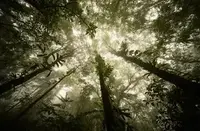Introduction
Can you find Bothriechis vipers at Mount Totumas during the dry season? That was the question I set out to answer when I visited Mount Totumas Ecolodge in early April, near the end of Panama’s dry season. While this isn’t the prime time for herping, I was willing to trade seasonal odds for a rare opportunity: the chance to observe resplendent quetzals in peak breeding activity, while also searching for two of my bucket-list pitvipers — Bothriechis lateralis (Side-striped Palm-Pitviper) and Bothriechis nigroviridis (Black-speckled Palm-Pitviper).
From the start, this trip was a calculated gamble — and a rewarding one.
Why Mount Totumas?
Mount Totumas is located at the edge of La Amistad International Park, nestled within a 400-acre reserve that protects both mid-elevation and high-elevation cloud forest. This elevation gradient makes it ideal for both birding and herping, and I’d been drawn to its reputation as a place where quetzals and pitvipers share the same canopy.
For planning, I referenced both the Mount Totumas Ecolodge page and my own Panama travel guide, which outlines seasonal access and gear recommendations.
The Viper Strategy: Birds, Snakes, and Seasonality
According to lodge owner Jeffrey Dietrich, Bothriechis species at Mount Totumas do not appear to follow strong seasonal patterns in visibility. This matched what little data I found on iNaturalist, and what I’d heard from guides in Monteverde, Costa Rica. Despite being the dry season, I expected that B. lateralis sightings were still possible — and possibly even B. nigroviridis, the herping holy grail of my trip.
I searched every night for ten consecutive nights, usually from just after sunset to midnight. I also hiked during the day, since Bothriechis species often remain in the same perch for days — visible even when inactive. The cool temps at the higher elevations might also force the vipers to be active in the day as well.
My best hope was to encounter B. lateralis, which is known to occur at lower elevations of the cloud forest, around the Bellbird Lodge and below. B. nigroviridis is assumed to inhabit higher elevations, though in my experience, the elevation range of both species may overlap considerably.
My Results: A Snapshot of April Herping
Despite relatively dry conditions — it only rained on three of my ten nights — I had productive encounters with several species. Amphibian activity was noticeably linked to rain; frogs only called on rainy nights, though one of the two shadowy salamanders was found on a dry night.
✅ Confirmed Herp Observations:
- Craugastor Frogs: Several individuals of two species, Craugastor crassidigitus, and Craugastor podiciferus.
- Mountain Stream Treefrog (Isthmohyla rivularis)
- Shadowy Salamander (Bolitoglossa sombra)
- Anole: Species unknown
- Emerald Swift (Sceloporus malachiticus)
- Side-Striped Palm Pitviper (Bothriechis lateralis): One adult and one juvenile observed directly; two additional juveniles found by coffee workers
The juvenile B. lateralis I found was crossing a trail near the Bellbird Lodge shortly after dark. The adult was perched in a small tree at head height, clearly visible on a solo night hike. I photographed it in situ and returned to the same location three days later — it hadn’t moved.
Reinaldo, one of the lodge’s guides, found both salamanders and several frog species during our night hikes, but no vipers. The additional B. lateralis juveniles were found by coffee workers, incentivized by a small bounty offered by Reinaldo — a practical and ethical way to crowdsource rare finds safely.
Pitviper Patterns and Altitude Zones
Although I searched intensively in higher elevation zones, I found no sign of B. nigroviridis. Reinaldo and several workers had previously seen, in the past, both nigroviridis and lateralis during the daytime, which may reflect searcher effort more than actual diurnal behavior.
“Most of our sightings have been during the day — not necessarily because that’s when the vipers are most active, but simply because that’s when we’re out there.” — Reinaldo, wildlife guide at Mount Totumas
Still, B. lateralis proved findable even during a dry spell, and based on my experience and species distribution data, I believe early rainy season (May–June) would increase both frog and viper activity considerably.
Advice for Herping Mount Totumas
- Go slow and search methodically. I had the most success walking quietly, scanning low vegetation, and pausing every few minutes. While fast hiking can increase the chances of coming across a snake crossing a path, you'll be unlikely to find well-camouflaged snakes in the dense vegetation. Furthermore, the one B. lateralis I found crossing a trail, it was moving slowly (hard to spot) and was in well-camouflaged in short green grass on the trail, and I don't think I would have spotted it if I was walking quickly.
- Don't skip daytime hikes. Some Bothriechis individuals are surprisingly easy to spot when motionless in good light. While they're less likely to be active during the day, they do have a tendency to remain in one spot for days on end, and do not seek shelter during the day as many other snakes do.
- Focus low elevations for B. lateralis. Lower elevations are in general more biodiverse and biodense and are more hospitable to reptiles. As long as you're well within their altitudinal range, which is the case for all of the Mount Totumas property, the lowest elevations might have the greatest concentrations.
- Explore post-rain. In general, rain brings life. Rain causes plants to bare fruit and seeds which bring out small mammals, and the increased humidity and puddles are necessary for many insects and amphibians to breed or become active. And when small animals are active, so are their predators, like snakes. In my personal experience, amphibian activity and viper movement increase significantly after rainfall.
- Ask the locals. The coffee workers and guides were invaluable allies — and their participation paid off.
- Don't follow my advice. Very little is known about montane pitvipers. The typical advice you follow for other vipers might not apply to the montane vipers, and the limited observational data available on the internet may not be statistically significant and representative of the animal's actual behavior. Rather, the data available may reflect human behavior more than the animal's.
For a broader overview of the region, including access tips, see my Panama travel guide, or visit the full Mount Totumas Ecolodge page with interactive trail maps, 360° virtual tours, and species profiles.
📸 Related Resources
Are you looking for more herping advice? Check out the blog on Best Times to See Reptiles and Amphibians in Costa Rica, and discover why Costa Rica's wet season offers prime herping opportunities.






